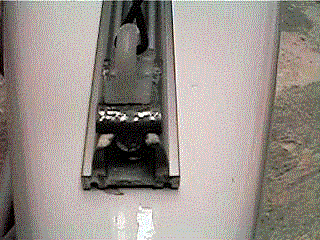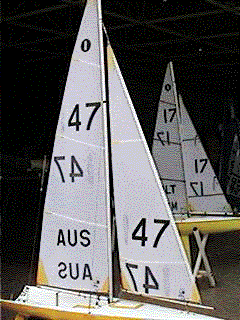Malta, April 5-10 1999
Day 2
On day 2 (I didn't see day 1), the wind was reliably between 2 and 4 m/s -
say 4 to 8 knots - and showed little in the way of shifts. The course was laid
in (small) Ramla bay in the Mediterranean Sea. Five fleets were run.
Down in D and E fleets I saw anxious skippers making errors that they would
never make at their local club regatta. Up in A and B fleets I saw anxious
skippers making errors that they'd never make... You get the picture. As far as
I could see, there was no particular design that was "on top". The top
TS2, Widget, Mirage/Rage, Scoop, and Ikon were simply being sailed by the top
skippers.
I found the quality of observing left much to be desired, surprisingly so at
a world class event. It seemed clear to me that some observers were blind,
period; then, some were simply blind to the errors of their compatriots; and
some, unfortunately, I thought were rather, er, inventive... The practice in the
event has been to have the first four finishers of a heat act as observers for
the following heat. Looking at it charitably, it seemed that these top four
skippers took up their observing duties with their minds still (understandably)
focussed on the race they just completed, rather than on the race in progress.
Day 3
Day 3 Wind: Started with all yachts in No.1, but all suited down to No.2
after a race or so, and then sometimes suited back up to No.1. It remained on
the edge between No.1 and No.2 for the rest of the day. Waves: starting about
1ft, building to 2ft, sometimes 2.5ft crest to trough.
The race committee changed the observing arrangements, so that the top four
skippers of the previous heat plus one were the specified observers for the
current heat. This allowed them time to cool down, and it seemed that the
standard of observing improved somewhat as a result.
Derek Priestley stormed through his B heat to earn promotion on the only set
of No.1's in his heat, then stormed the next race in A heat for a win (now
sensibly on No.2's). His adrenalin overload took him to last on his next A heat
outing, though, and demotion to B again. In the mean time, Ken Binks was
watching the B heat and, with Derek's success in B heat using the No.1 rig
obvious, rapidly changed to No.1 for his A heat race. The other A heat
competitors played safe and stayed with No.2's. The wind promptly picked up a
knot or two while he was changing, and Ken won a demotion to B for his trouble.
Graham Bantock consolidated his position in first place in the event with a
perfectly sailed tactical race. Positioned somewhere around sixth on the first
windward beat, he maintained his port tack for 10 or 15 seconds longer than
strictly necessary, allowing three or four boats to pass him, until Paul Jones
come into range. He then tacked onto starboard and caught Paul on port so
effectively that Paul stalled and lost two or three vital positions as a result,
causing him demotion to B heat in the next race.
Trevor Binks and Richard Rowan began getting the hang of things -- probably
by the simple expedient of relaxing and letting their boats run freely -- and
posted a series of very fine results in their A heats. These two skippers turned
in the "most improved" results of the event. Richard had the best
prepared yacht of the event as well, with superb attention to fine detail on all
aspects of his rigging and fittings.
Craig Smith had a terrible day. From heading the leaderboard he tangled up at
the leeward mark with some tail-enders and was demoted into B heat. While
fighting his way out of B his batteries gave up, and this earned him an
embarrassing trip down to C, almost certainly putting paid to his hopes of
keeping his World Championship.
Simon Kellett posted the luckiest break of the day, and probably of the
event. Seeking a good result in A, he changed up to No.1 at the last minute, but
arrived at the launching platform as the one minute warning sounded, and was
required to hold his boat ashore until he could launch at the starting signal.
To the cheers of the spectators, the mass of the A fleet promptly sailed over
the line early, causing a general recall. Simon launched and went on to win the
restart.
There was an interesting distribution of skipper "noise" over the
five fleets. E and A fleets were the quietest with hardly a protest or a contact
called. In the case of the A fleet skippers, they knew exactly what they were
doing and by and large they did it well and comfortably, within both the spirit
and letter of the RRS. In the case of E fleet, the skippers knew what they were
meant to do and didn't complain when they largely failed. Moderately noisy were
D and B fleets. The noisiest of all was C fleet, with incessant and fruitless
shouting of the sort "I protest the white boat", with never an
indication of either their own jib number or that of the "white"
boat.... I thought this was partially due to the high denisty of Mediterranean
and Southern European skippers here, but that it was also due to the fact that
the skippers in C were frustrated and annoyed. In this fleet, sailing was
cutthroat, and, more than occasionally, deliberately foul. It turned out that
the international jury was mostly exercised by C fleet protests that were mostly
bloody-minded.
Day 4
Day 4 was very similar to the previous day, except that the wind ensured No.2
suits for almost everyone throughout the day. Choppy waves were consistently
between 2ft and 3ft crest to trough.
Martin Roberts emerged as the main challenger to Graham Bantock as
Pierre-Luigi Puthod, Paul Jones, and Craig Smith languished in lower fleets.
Ante Kovacevic and Richard Rowan continued to post good finishes, as did Ken
Binks and Trevor Binks. The Binks boys in fact managed to finish 1-2 in race 17
to the delight of the onlookers.
I watched as Vjeko Orlandini seemed to mount a search-and-destroy mission in
A fleet. Vjeko started out by sailing Graham off the windward mark for the loss
of five places. He then tangled up with Ken Binks twice, forcing Ken down into B
fleet. Later in the day, Vjeko apologised to Graham, saying he had
"lost" his boat and had been "sailing" another.
The conditions were in fact very difficult. Keith Skipper reminded me of a
similar incident that he knew of:
"Two of the top skippers were sailing around a mark. One called for
water and the other agreed he was entitled to it. However there was contact
going round the mark, so the one who had agreed to giving water said he would
do a turn. When he did, he found that it was the inside boat that he had been
controlling!!! (And they weren't even sailing the same design....)"
Day 5
Wind as for day 4, but with the waves slightly higher.
As the event drew to a close, Vjeko's errors of the previous day proved fatal
to Ken Binks' hopes. A pretty secure 5th place and possibility of 4th place
turned into an 8th as a result, and the usually easy and outgoing Eastbourne
skipper turned dark and angry.
Elsewhere, Craig Smith recovered to second place overall as the third discard
kicked in, and gave some fine results in A to show that, had his batteries not
failed earlier, he would have given Graham a very close fight indeed. Paul Jones
similarly recovered after blowing up two Rx's, and I was touched to see Ken
Binks helping Paul to repair his electronics with complete enthusiasm, knowing
full well that Paul was one of his main competitors and that he was almost
certainly helping Paul beat him out of 6th place.
Martin Robert's superb claim to second place was thwarted by exceptionally
aggressive sailing by Beltri in the last race of the day, and Martin had to
settle for third. To his credit, Martin was the only skipper I saw who routinely
and stoically took his 360 penalties immediately he realised he had infringed.
No other skipper was as ready to admit and correct his mistakes, with most of
them doggedly sailing on after some pretty blatant errors and preferring to wait
to be called by an observer and risk two 360's. Unfortunately, from what I saw,
such tactics almost certainly paid off...
At the end
Given a different throw of dice, it seemed to me that any skipper in the top
9 could have taken the event. Graham's win reflected a solid consistency that
kept him in A fleet in every race (Martin Roberts also kept up in A fleet for
the whole event), while every one of the other top 7 all had one or two
demotions down to B heat at some point in the event. Success in the event came
from an ability to adapt to the rough seas and to both tune and sail the yacht
appropriately.
It seemed that the TS2 was indeed the design best suited to the event's
conditions. That the Ikon, Widget, and Rage/Mirage did well at all was more a
testament to their skippers. Pierluigi Puthod's narrow beam Scoop2 sported a
particularly narrow chord fin, and could have been a devastatingly effective
yacht in lighter air and smoother water -- but that was not to be.
Pictures
Richard Rowan had the very best jibstay and jib downhaul arrangement that I
saw.
 
A number of the Italian boats used fittings made from simple domestic curtain
track. The plastic slider for the track had its shaft and base shaped so that it
could be inserted into the track and then turned a quarter turn to click it into
place. The key to the idea was a piece of spring steel between the track and the
plastic slider, through which the shaft of the slider was located. The spring
had its forward and rear edges bent and shaped so that a small tongue kept the
spring located on the track, and the bent edge itself bit into the soft track.
 
Graham's boat showed two unusual features. One was a little aerodynamic
fairing over the spreader tubes, but more interesting was the use of a flat
steel "tape" for the shrouds, rather than the usual stranded wire. On
Graham's boat, the spreaders were locked into the shrouds by being firmly pinned
into place.

Craig Smith's jib had an unusual cut. The bottom panel was the minimum legal
height, and the middle panel then took up the rest of the lower two-thirds of
the sail. It seemed shaped, to me, to provide extra draft in the stillness of
the assembly room, but on the water may have shown different characteristics
depending on the jibstay sag allowance.

One of the Italian boats had an arrangement on the spreaders to fend off a
loose and floating topping lift -- a length of cable-tie. I was surprised it had
passed measurement, since it seemed clearly out of class to me.

2005-12-18 | 